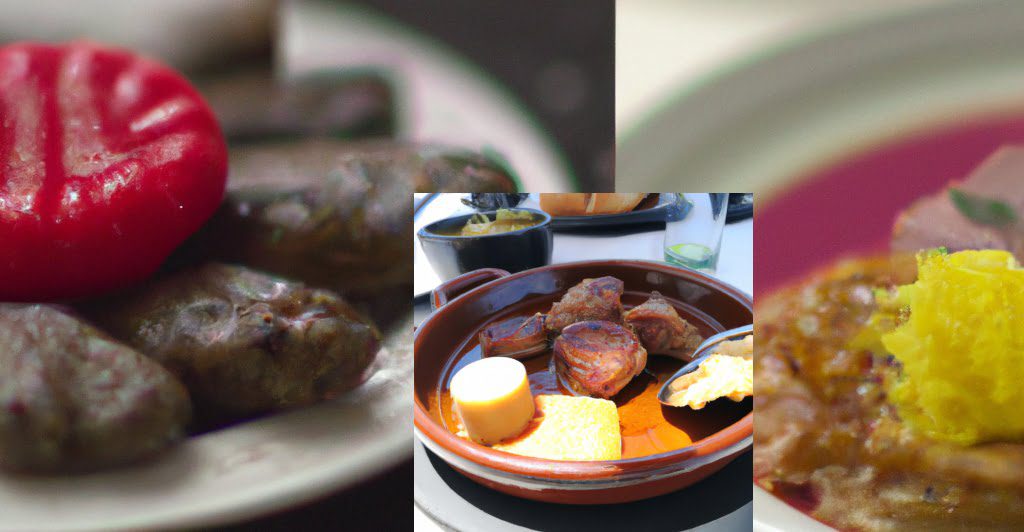Experience the unique food culture and dishes of Andalusia, a region in southern Spain known for its rich culinary heritage. From Tapas to Paella, explore the flavours of this vibrant region.
Andalusia is a region in the south of Spain that is known for its unique food culture and dishes. The region is home to a variety of traditional dishes that have been passed down through generations, as well as modern interpretations of classic recipes. From the famous tapas of Seville to the seafood of Cadiz, Andalusian cuisine is a delicious mix of flavours and textures. The region is also known for its use of fresh, local ingredients, which give the dishes their unique flavour. Whether you’re looking for a light snack or a full meal, Andalusia has something to offer everyone. In this article, we’ll explore the unique food culture and dishes of Andalusia.

The Influence of Moorish Cuisine on Andalusian Dishes
The influence of Moorish cuisine on Andalusian dishes is a story of cultural exchange and culinary creativity. It is a story of how two distinct cultures, with their own unique flavours and ingredients, blended together to create something entirely new and delicious.
The Moors, who ruled much of the Iberian Peninsula from the 8th to the 15th centuries, brought with them a variety of spices and flavours from North Africa and the Middle East. These flavours, combined with the local ingredients of Andalusia, created a unique and flavourful cuisine.
The Moors introduced a variety of spices, such as cumin, coriander, saffron, and cinnamon, which are still used in many Andalusian dishes today. They also introduced a variety of fruits and vegetables, such as oranges, lemons, and artichokes, which are now staples of the Andalusian diet.
The Moors also introduced a variety of cooking techniques, such as grilling, roasting, and stewing, which are still used in many Andalusian dishes. They also introduced a variety of sauces, such as romesco and mojo, which are still popular today.
The influence of Moorish cuisine on Andalusian dishes is evident in the variety of flavours and ingredients used in the region. From the spices and fruits to the cooking techniques and sauces, the Moorish influence is still present in many of the dishes served in Andalusia today.
The influence of Moorish cuisine on Andalusian dishes is a testament to the power of cultural exchange and culinary creativity. It is a reminder of how two distinct cultures, with their own unique flavours and ingredients, can come together to create something entirely new and delicious.
Exploring the Unique Ingredients of Andalusian Cuisine

The cuisine of Andalusia is a unique and delicious blend of flavours, textures, and aromas. From the sweet and savoury flavours of the region’s famous Gazpacho to the rich and creamy flavours of its famous flamenco-style Paella, Andalusian cuisine is a culinary experience like no other.
At the heart of Andalusian cuisine are its unique ingredients. From the sweet and smoky flavours of Pimentón de la Vera to the nutty and earthy flavours of Almendras, Andalusian cuisine is full of unique flavours that will tantalise your taste buds.
The region’s famous Gazpacho is a perfect example of the unique ingredients that make up Andalusian cuisine. This cold soup is made with a variety of vegetables, including tomatoes, cucumbers, peppers, and onions, and is blended with olive oil, garlic, and vinegar. The result is a refreshing and flavourful soup that is perfect for a hot summer day.
Another unique ingredient in Andalusian cuisine is the region’s famous flamenco-style Paella. This dish is made with a variety of ingredients, including saffron, garlic, onions, tomatoes, and a variety of seafood. The result is a flavorful and aromatic dish that is sure to please any palate.
Andalusian cuisine also features a variety of unique spices and herbs. From the sweet and smoky flavours of Pimentón de la Vera to the nutty and earthy flavours of Almendras, these spices and herbs add a unique flavour to any dish.
The History and Evolution of Andalusian Dishes
The history of Andalusian dishes is a story of evolution and innovation. It is a story of a culture that has embraced the flavours of the world and made them its own.
Andalusia, located in the south of Spain, has been a melting pot of cultures for centuries. From the Romans to the Moors, each group has left its mark on the region’s cuisine. The result is a unique blend of flavours and ingredients that have been passed down through generations.
The traditional Andalusian diet is based on fresh, seasonal ingredients. Olives, tomatoes, garlic, and onions are staples in many dishes. Seafood is also popular, as the region is surrounded by the Mediterranean Sea.
The evolution of Andalusian cuisine is ongoing. Chefs are constantly experimenting with new ingredients and techniques to create unique dishes. The result is a vibrant and diverse cuisine that is enjoyed all over the world.
Andalusian dishes are a celebration of culture and flavour. They are a reminder of the region’s rich history and its ability to embrace the flavours of the world. They are a testament to the creativity and innovation of the Andalusian people.
Exploring the Rich and Varied Cuisine of Andalusia
From the sweet and savoury flavours of the Mediterranean to the spicy and exotic flavours of North Africa, Andalusia has something to offer everyone. The region is known for its abundance of fresh seafood, from the succulent shrimp of the Atlantic coast to the delicate anchovies of the Mediterranean. The seafood is often served with a variety of sauces, such as the classic aioli, a garlic-infused mayonnaise.
The region is also known for its abundance of vegetables, from the sweet and juicy tomatoes of the south to the earthy and nutty artichokes of the north. These vegetables are often served with a variety of sauces, such as the classic Romesco, a nut-based sauce.
The region is also known for its abundance of spices, from the smoky paprika of the south to the fragrant saffron of the north. These spices are often used to flavour a variety of dishes, from the classic Paella to the more exotic Tagines.
Andalusia is also known for its abundance of fruits, from the sweet and juicy oranges of the south to the tart and tangy lemons of the north. These fruits are often served with a variety of sauces, such as the classic Almibar, a syrup made from sugar and citrus juice.
The cuisine of Andalusia is a unique and delicious blend of flavours, textures, and aromas. From the sweet and savoury flavours of the Mediterranean to the spicy and exotic flavours of North Africa, Andalusia has something to offer everyone. Whether you’re looking for a light and refreshing meal or a hearty and flavorful feast, Andalusia has something to satisfy your taste buds. So come explore the rich and varied cuisine of Andalusia and discover a world of flavour!
By Sofia
Free Member of the Food Culture Community


